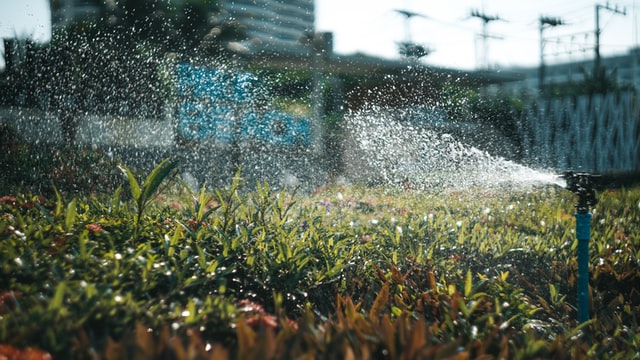If your yard was overrun by weeds this winter or if you want to plant grass seed in a totally new location this year, you’re probably starting from scratch. Planting grass from seed to establish a new lawn may feel intimidating, but by following a few key principles, you’ll be on your way to a lush new lawn.
Pros & Cons of Seeding a New Lawn
There are several ways to start a new lawn, but seeding has some distinct advantages. Seeding is the cheapest and easiest do-it-yourself option. Starting a lawn from seed also allows you to cherry-pick the grass species you want to grow, an option that’s not always available with sod.
The downsides to seeding are the limited windows for starting your lawn and a longer establishment period. But for long-term value, it’s hard to beat the cost of a seeded lawn!
When is The Best Time to Plant Grass Seed?
It depends where your lawn is located! In the northern part of the US, the best times of year to plant new grass seed are in early spring (before June 15) or late summer (late August). In middle to southern regions, cool season grasses are best established in fall. The cooling days and nights help new grass seedlings get a foothold well before the stress of heat or drought comes on. Getting the timing right is one of the biggest factors in your new lawn’s success.

image by North Dakota State University
Before any work begins, let’s assess your situation.
- Are there any slope or drainage issues to correct?
- What are the soil conditions? Rocky, compacted, sandy?
- How much sun/shade does the location receive?
- Will the area receive excessive foot traffic?
- Do you have adequate irrigation or convenient access to water?
Addressing these factors upfront will spare you many headaches down the road. If runoff is a concern, investigate grading and drainage collection or dispersal options before spreading any seed. Rolling hills are fine, but consider where water will flow or collect in heavy rain. Make sure the grade around your home or structures is away from the building.

Measure the area to calculate your grass seed, lime, and fertilizer needs. Now is also a good time to get a soil test for precise lime and fertilizer recommendations. Wisconsin Cooperative Extension provides an excellent soil testing guide. Over-fertilizing lawns is not only harmful to your grass and wallet but also to local waterways. Get a soil test so you know your numbers and can give your grass the exact nutrients it needs.

Prepping the Site
If there is any existing vegetation, you’ll need to terminate the grass or weed competition with a non-selective herbicide. New grass seedlings can’t outgrow established weeds or sod. Start early enough on this task so the vegetation can die back completely.
Till the soil to a depth of 4-6”. If you are working in heavy clay or sandy soil add 1-2 cubic feet of compost, then broadcast lime and lawn starter fertilizer according to your soil test results. It’s important to add fertilizer before planting. Nitrogen for green growth, phosphorus for strong rooting, and potassium for pest and stress tolerance. Mix the amendments into the soil and rake or harrow the area to level and smooth the seedbed. Remove any rocks, twigs, or debris.
Roll the area to settle the soil and then lightly rake the top layer to prepare for the new seed. It may be tempting to shortcut some of these steps, but you don’t get a second chance to do site prep right. Your reward will come this summer!

How to Choose the Best Grass Seed For Your New Lawn
It’s important to choose high-quality, certified grass seed for your lawn. There is a dramatic difference in germination rates and weed seed quantities with high-quality seed. If you’re going to the trouble to seed the ground, now isn’t the time to skimp.
Consider a mix of turf-type grasses. Turf-types are specially designed for lawn use, not pastures. Improved turfgrass cultivars have been bred to withstand drought or shade, resist disease, handle foot traffic and other factors common for lawns. Choosing a mix of seed varieties provides the benefits of multiple varieties.
Deer Creek Seeds offers turf-type mixes for all conditions including:
- Warm areas needing disease resistance (Five Way Fescue Turf Mix)
- Fast draining soils (Sandy Soil Turf Mix)
- Low growing varieties for low maintenance/input areas (Low Grow Fescue)
- Low light or mixed sun/shade lawns (Shady Turf Mix)
- Quick results (Speedy Green)
Plus, we offer all-purpose blends like our Sun & Shade Turf Mix and Sunny Turf Mix which both include multiple season-appropriate improved turfgrass varieties.
Be sure to keep a record of the seed you plant for future fertilizer recommendations and overseeding when necessary. An easy way to keep track is to snap a picture of the seed label and add it to your favorites photo album for future reference.

How to Plant Grass Seed
Once you have a clean, well-prepared seedbed, and with high quality seed in hand, you’re ready to go.
- Spread the Seed

Sow your grass seed at the recommended rate, typically 3-10 lbs per 1000 square feet, using a rotary or drop spreader. Follow a “plus sign” pattern. Use half the rate and make one pass in a north/south direction and then spread the remaining half going east/west. (Image by Texas A&M AgriLife Extension)
- Cover and Mulch
Lightly cover the seed to ¼” depth by raking or dragging the area. Roll again to firm the ground and ensure good seed to soil contact.
Mulch the new grass seed with a weed-free straw at a rate of 50 lbs per 1000 square feet to conserve moisture. Apply twine netting to sloped areas to prevent seed erosion from water or wind, if necessary.
- Water
Finally, lightly water the new seed with a fine spray setting to settle the mulch and prompt seeds to germinate. Keep the top inch of the seedbed moist for 14-21 days and then gradually reduce watering as seedlings sprout. Do not allow the area to completely dry out until the grass is well established, 45-60 days.

New Lawn Care Tips
Irrigation
After 60 days you can begin treating the area as an established lawn. Sufficient water is essential, but the amount of water your grass needs depends on your type of grass, soil type (sand or clay), and even property slope. Your goal is to water long enough so that the ground is wet to the grass’ root depth. In the Upper Midwest, that’s generally an inch of water per week during the growing season.
Sandy soils need more frequent watering than heavy clay soils. If you don’t have in-ground irrigation, move your sprinkler around the yard so that water soaks into the ground and doesn’t simply runoff. The best time to water your lawn is in the early morning when it’s cooler, less windy, and more humid outside. Less water will evaporate, and more will actually soak down to the roots.
‘Footprinting’ is the crispy, off-color spots your grass shows when it’s dry. It’s a sure sign that it’s time to water. Aim to water your grass less often but more deeply to encourage roots to dive deep into the soil. Your summertime lawn will be greener and healthier for it!
Mowing
You’ll want to start mowing your new lawn once it reaches 4 inches tall. Keep mower blades sharp for a clean-cut,and only remove small amounts of the grass blade each time. Adjust your mower height before you start so that you never remove more than ⅓ of the grass height each time.
Excess water and fertilizer drive grass growth (and potentially disease) which means more mowing for you. Save yourself some time by watering and fertilizing only as recommended. When possible, use a mulching mower blade to return the grass clippings and their nutrients to the soil. Contrary to popular belief, grass clippings don’t cause thatch, over-fertilizing does!
Weed Management
For spring-planted lawns, crabgrass can be an issue. Michigan State University recommends using Siduron preemergence immediately at planting to control crabgrass. Because it is a summer annual, crabgrass is unlikely to be a fall problem. Broadleaf weeds can be sprayed with an appropriately labeled broadleaf herbicide once the grass is being regularly mowed.
Foot Traffic
New grass seedlings are tender plants. Try to avoid the area until the grass has matured at least a month. Watch for areas of drought or traffic stress that may need extra water or protection to preserve the stand.

A new lawn is an investment that increases the function of your yard and curb appeal of your property. Taking the time to methodically follow these best practices will provide the greatest likelihood of success. Do it right once and spend next summer enjoying the fruits of this year’s yard labor.

Additional Resources:
- The University of Wisconsin Extension has an outstanding Lawn Establishment & Renovation guide that compares seed vs sod and has a handy key to reading seed bag labels.
- North Carolina State University Extension has an exhaustive handbook on lawn establishment for those in transition zones who may be deciding between warm and cool season species.
- Michigan State University offers an excellent overview of establishing a new lawn from seed. It includes detailed descriptions and photos of turf-type varieties appropriate for the region.
- Texas A&M University’s Agrilife Extension provides a useful guide to establishing turfgrass in Texas, including some nice graphical charts comparing turfgrass species.
- The USDA Natural Resources Conservation Service of Michigan has a helpful pamphlet on the 5 Keys to Successful Grass Seeding including a nice table of seeding rates for various lawn grass seeds.
- Virginia Tech University Extension has a concise pamphlet on establishing new lawns.
- The University of Wisconsin Extension provides a handy calendar-style reference guide for how to maintain your lawn month by month. The University of Illinois Extension has a similar, more concise guide that you could even post in the garage or next to your calendar.
- The University of Georgia Extension publishes a versatile checklist of steps to healthy home lawns. While it is written for southern climates, it’s principles are useful in multiple areas.



